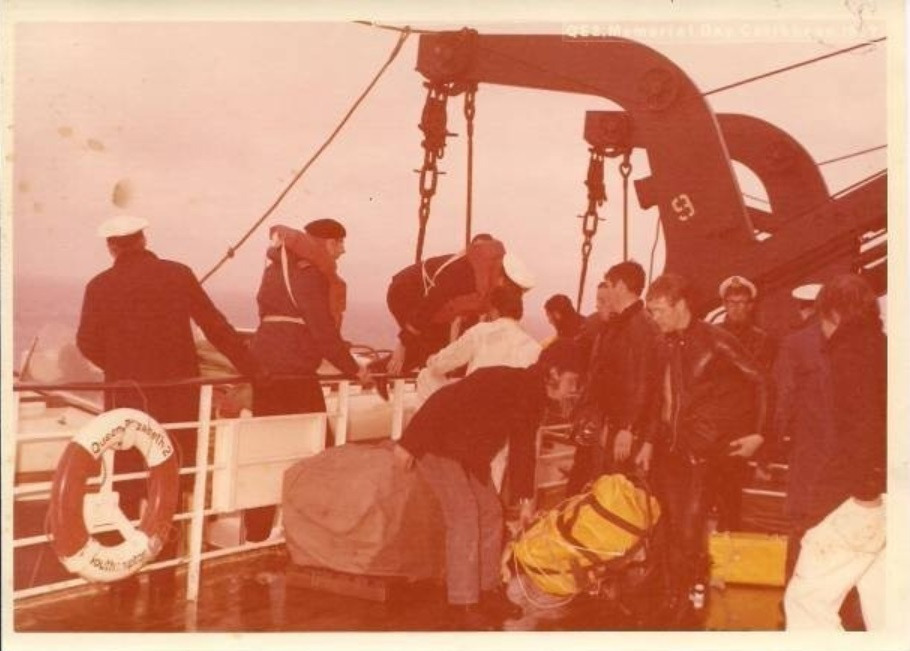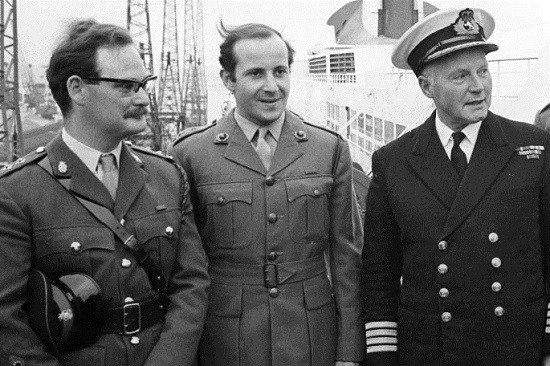
The Full Story of QE2's Infamous Bomb Scare
When four bomb-disposal experts were dropped into the Atlantic amid a bomb-scare drama, they had no idea their mission involved saving the QE2 from one of history’s infamous hoaxers.
May 17th, 1972, was a Wednesday.
A normal Wednesday for Charlie Dickson, finance director of the Cunard Shipping line.
Lunch had been conventional. New York weather conditions were typical for the season. The afternoon was pressing on as expected, with a familiar schedule dictating proceedings.
Until his desktop phone rang shortly after 3pm.
Collecting the receiver amid the accustomed procedure, Charlie’s blood suddenly ran cold. An unfamiliar voice demanded $350,000 or six bombs hidden aboard the QE2 would be detonated with deadly force.
The muffled voice highlighted that two accomplices were aboard the Cunard liner, and these men were primed to detonate explosives regardless of the risk to their lives.
One accomplice was described as an ex‐convict “who did not care whether he lived or not” and the other as a “terminal cancer case who did not have long to live.”
At that moment, the QE2 was midway through a cruise from New York to Cherbourg. Crossing the deepest Atlantic waters with 1438 passengers on board, alongside almost 800 crew members, the ransom was not to be dismissed as a hoax.
The caller whispered his threat before being replaced with the click of a switchboard’s dial tone.
The ship’s captain – William Law, making his first voyage as the QE2's master – was immediately alerted to the situation. He ordered all doors to be sealed and instigated a search for any foreign devices lurking within less-populated areas of the $78-million liner.
When news of the threat reached London, Cunard's managing director, Norman Thompson, quickly conferred with Defense Ministry officials.
Within a matter of minutes, the FBI and London’s Special Branch were employed to widen the investigation, while Her Majesty’s Ministry of Defence received instructions to prepare a flight for a military team out to the 65,000-tonne flagship.
Welshman Captain Robert Hacon Williams, aged 29, was chosen to lead the operation. The Army Ordnance Corps Ammunition Technical Officer and bomb-disposal expert was having a fairly normal Wednesday.
Pulled out of a lecture he was hosting for new recruits, Williams was suddenly bundled into a helicopter bound for RAF Lyneham, where three other soldiers and a fully-fuelled C-130 Hercules awaited his command.
The four-man team had been told very little, given a short brief that outlined their mission to board an unnamed ship at sea, first by parachuting into the ocean. This was a feat Williams had never attempted before.
As it turned out, May 17th was going to be far from normal.

QE2: Held to ransom
As Britain’s military scrambled to provide assistance, back in New York, Charlie had received a letter from the extortionist. The $350,000 ransom was to be constructed of $10 and $20 notes, and delivered in a blue bag to a telephone booth in New Peitz, north of the city.
The note concluded that Charlie should come alone at 9:30 pm, or he would “have a catastrophe” on his hands. He had little choice but to comply.
With top-brass management fearful of the repercussions, and the status of British military intervention yet to be fully disclosed, Dickson refused the FBI’s offer of handling the drop, and instead set off with the money; shadowed by plain-clothed FBI agents.
Captain Law had been instructed to use his discretion about telling passengers or leaving them blissfully unaware. His decision to share the news stemmed from efforts by correspondents to reach the ship regarding the situation via telephone and fax.
“The Queen is taking no calls and receiving no radiograms,” operators in London reported.
Captain Law was met with a stunned wall of nervous terror upon informing passengers of the bomb threat. An anxious round of questioning emerged from huddled groups, where staff repeated their knowledge of a British bomb disposal team who were en route.

Just a drop in the ocean
There was also growing trepidation for the four-man team as their Hercules approached the drop zone. The conditions for parachuting into the Atlantic were far from favourable. Cloud cover and thick rain made visibility difficult, with a 20-knot wind adding to complications.
The plan called for Captain Law to reduce QE2’s speed, and sail her into the wind to create shelter. Assisting the situation, alongside Williams, were Sgt. Clifford Oliver, Lieut. Richard Clifford and Cpl. Thomas Jones.
Courtesy of poor visibility, the Hercules pilot had an almost impossible task as all conditions were below minimum. Flying at 200 feet, he had to sight the ship before pulling up and climbing as vertically as the plane could manage.
According to eyewitness accounts, the plane's loadmaster had to push the team out of the plane, as gravity had pinned them to the floor. They jumped in pairs, and the passengers watching from the ship's railings cheered when four parachutes emerged from the cloud bank.

Captain Williams hit the water hard, and although the QE2 was within reach, it took enormous effort to battle against the ocean’s tumultuous surface. Williams and his team plunged into the ocean from such a height, and with such force, that they descended 30 ft beneath the waves before surfacing.
Spectators reported that the trained parachutists dropped from their harnesses and swam towards Captain Williams following his painful impact.
Still reeling from a difficult landing, Williams eventually caught his breath once his team were successfully aboard the Cunard vessel, having been fetched by launches from the ship. It was here that a full brief was issued, and the team were quickly ushered to areas where they believed bombs may be located.
The first port of call for Williams was the ship's hospital after being sick, then on to the bridge for the slickest 007-inspired move of all time; handing Captain Law that day's Daily Telegraph kept within his wetsuit.
Scouring the ship was going to require a mammoth effort. At 963ft long, 105 ft wide, and 13-decks high, the QE2 was one of the largest liners built at the time.
As the onboard search began for suspicious packages, Charlie arrived at the rendezvous point. The extortionist called the phone booth at exactly 9.40pm and gave instructions to drive a few miles away.
Charlie was advised to go into a diner, where instructions would be taped under a basin in the Gent’s toilets. He was to follow the mandate precisely.
Dickson left the financially-heavy bag in a discreet spot near a construction site as per the instructions and walked off into the night, while the FBI loitered in the darkness.

A bomb onboard?
Emotions were running high aboard the QE2. Passengers flinched when unexpected sounds – clinking cutlery, moving chairs, raised voices – pierced the uneasy ambience. Everyone waited with bated breath – and fate didn’t seem far away.
A large suitcase had been located and Williams felt the weight and bulk were somewhat suspicious; especially as no owner could be traced. The moment of fear was brief, however, as when Williams blew open the lock the contents presented themselves – a large quantity of dirty laundry and some books.
By the early hours of May 18th, following an exhaustive combing of the vessel, Williams concluded that the entire affair had been a hoax. Now it was down to the FBI and their plain-clothed team to track down the extortionist – something that would take time; as the caller never showed for his money.
The captain announced that the first-detailed inspection had found nothing untoward, and that “so far the results have been reassuring—their examination proved negative.” He explained that the search would continue, although he believed everyone was perfectly safe.

The hoax is revealed
Cunard officials originally ran with the concept that the bomb scare could be a hoax. However, they were not taking any gambles. Every precaution had to be exercised for the safety of passengers and the ship.
“I think it is probably 99 per cent certain to be a hoax or a trick, but I cannot take the risk,” said Victor‐Matthews, Cunard's chairman, at the time.
The management’s reaction came from the experience of previous turmoil aboard QE2. Only two years earlier, in September 1970, the bridge and engine room were locked down during an eastbound Transatlantic voyage due to fears she would be hijacked.
This scare came only a matter of months before passengers were prevented from boarding at Southampton; following an anonymous call claiming a bomb had been installed on the passenger decks. After a thorough inspection, no explosive devices were found.

The culprit is arrested
During this era of ocean-going travel, hijackings, bomb scares, and ransom demands were commonplace. Cunard had been subjected to these threats before, and the lingering case of the 20,000-tonne Portuguese Santa Maria – where rebels held 600 passengers hostage for two weeks – proved that every situation should be catered for.
Except, this hoax wasn’t masterminded by lavishly-funded rebels, or by Ernst Stavro Blofeld, or a kingpin of the criminal underworld.
In fact, the culprit was a 48-year-old shoe salesman from New York – by the name of Joseph A Lindisi – operating Joseph's Bootery at 331 Main Street, in Beacon, and living there with his wife and two children.
Cunard was not the first target for Lindisi. He had also picked a fight with American Airlines and threatened to blow up their terminals – while people were still inside.
Clearly operating with a distinct lack of common sense, Lindisi asked for the same blanket amount of $350k with each new threat, allowing the FBI to close in.
Lindisi also opted to use the same construction site for various drop-offs, including Charlie’s donation from Cunard. Thanks to a common thread, the FBI arrested Lindisi at his favourite construction site when he eventually turned up to collect his ransom money.
Charged with extortion and sending threatening communications, he was promptly jailed for 20 years and fined $10,000.
There was an extra twist in his cause for extorting cash from the globe’s largest travel merchants. Lindisi’s shoe store was situated in the middle of an urban renewal project, and his business had plummeted during the months prior to phoning Charlie Dickson at Cunard.
The disruptive construction in the area had effectively destroyed his livelihood, but that was nothing compared to the disruption he had singlehandedly caused for Cunard, the British military, the FBI, and hoards of anxious passengers.
Lindi’s actions spearheaded a change in security for Cunard and other shipping lines. While passengers could once invite people aboard to mingle before they departed on a voyage, strict new regulations prevented anyone without a ticket from getting near the ship.

Captain Williams and his team were awarded the Queen’s Commendation for bravery for their efforts, while the QE2 continued into the history books as a firm favourite for global travellers. The world continued to turn, and Wednesdays became somewhat normal again.
The events gave birth to a 1974 cinematic retelling with Williams portrayed by Richard Harris. The film also featured Sir Anthony Hopkins, Ian Holm, and Omar Sharif – not that production went smoothly.
However, that’s a completely different story.
------------
For more information on the military aspects of this story, and further pictures, head over to Royal Marines History.


